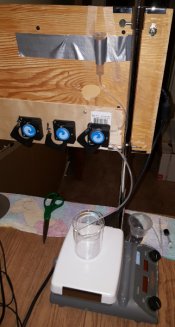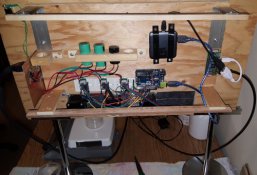Hi Roger,
Great question! I really don’t know the answer, but I’ll give you my thoughts based on my experience and what I’ve read in this forum.
It depends what level of sophistication you are trying to achieve. What emulsion are you making? Size, shape and placement of the nozzle will all affect the mixing, but in what way and to what effect, I can’t say. Usually, intimate mixing during precipitation makes for more reliable emulsions. This means you want a steady stream, injected directly at the mixing point. If you’re using a stirring hotplate, you’ll want the input jets to be as close to the stirring bar as possible (and close to each other if doing double jet).
For controlled emulsion making, it’s important for accurately know the flow of each jet, so the tip of the jet should be well defined and repeatable.
For uncontrolled emulsion making (no pAg measurement), restricting the diameter of the nozzle increases the backpressure, and makes it easier to deliver a more consistent flow. Depending on the emulsion and your steadiness in depressing the syringe, changing the nozzle shape and size might not make much of a difference to the emulsions characteristics. Squishing the tip with some pliers might help you to maintain a more consistent stream than a dripping one.
I’ve tried using metal luer lock needles, and even the ones that claim to be stainless corrode. I’ve given up on any metal injection tip. I found some
teflon ones, but they leaked. I really hate those luer connections. They always leak! I don’t know why they ever came to be standard.
I was considering getting some glass tubes and pulling my own tips, but I couldn’t come up with a great method to attach the glass to the tubing coming out of my pump or syringe. Glass is nice because it is inert and can be easily cleaned. Also, the shape of the cross section stays extremely consistent when you pull it.
The next thing I’ve been meaning to try is some very narrow ID
hard plastic (PEEK) tubing. This is used under high pressure for liquid chromatography, but it should have a well defined ID ranging from 30 thou (0.76 mm) all the way down to 5 thou (0.13 mm). This should be good for small batches. I’m not sure how I will cut it to avoid deforming the tip. I was thinking I would snip it and then sand down the tip to remove any material that was deformed by the snipping. I imagine you could check the shape and size of the bore under the microscope. The tube is 1/16” (1.6mm) OD, I was just thinking of sliding it inside some soft tubing with a 1 mm ID, and maybe looking for a tiny hose clamp if need be.
I know a former contributor to the forum, Kirk Keyes, used 28 gauge (0.32 mm) teflon tubing which seemed to work well for him.
Nice to see someone new posting this subforum; welcome!
Ian














